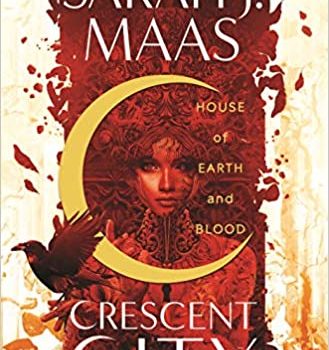Katharine Coldiron Reviews House of Earth and Blood by Sarah J. Maas
 House of Earth and Blood, Sarah J. Maas (Bloomsbury 978-1-63557-404-3, $28.00, 816pp, hc) March 2020.
House of Earth and Blood, Sarah J. Maas (Bloomsbury 978-1-63557-404-3, $28.00, 816pp, hc) March 2020.
Sarah J. Maas’s sales numbers make for a reputation that precedes her. Her YA novels, including A Court of Thorns and Roses and Throne of Glass, have sold millions of copies and made her a New York Times bestselling author many times over. Her fans are wild for her work, loyal and loving in a way authors dream about, so the quality of House of Earth and Blood, the first of her Crescent City books – a series for adults – is almost irrelevant, as far as the publishing industry goes. It will sell millions, it will make readers happy, and Maas will write more books. Que sera, sera. Whether doing so is beside the point or not, though, my job here is to assess the merits of House of Earth and Blood. This hefty novel introduces the reader to the city of Lunathion (AKA Crescent City), on the planet of Midgard, where humans and the Vanir (supernatural creatures: angels, shifters, the fae, etc.) live uneasily together. Multiple narrators explicate, in excruciating detail, the 25th year of Bryce Quinlan, a half-human, half-fae young woman with an exceptional life and destiny. The book, an original fantasy – unlike Maas’s earlier work, which was inspired by fairy tales – blends structural elements of several genres: the twisty plotting of a mystery novel, the predictable arc and heat of a romance novel, the breathless emotional stakes of YA. There’s also cosmic power and malevolence akin to a horror novel in the mix. The plot hangs largely upon who killed Bryce’s best friend, but House of Earth and Blood includes dozens of characters and complicated systems of governance, caste, and police presence, making the plot a maze.
If I had written this review based only on the first 90 pages, I would have to join the Witness Protection Program to hide from Maas’s fans. The beginning of this 800-pager is simply awful, rife with the kind of fantasist characterization and shoehorned exposition that teenagers write on the internet in anonymity. I was afraid of what I’d have to say in this space if the book had continued to be so bad as its initial eighth, but, thankfully, it got better. The problem of Maas really needing an editor to mitigate her worst habits did, however, continue. Her main character turns out to be a world-class Mary Sue, a kind of Swiss Army Knife of supernatural ability. Often, the reader’s inability to predict what comes next depends not on organic character and plot movements, but on the narrators keeping secrets from the reader. This is a cheap way to spice up the plot, to just not reveal something urgent and relevant that it would be natural to know or explain.
Further, Maas’s writing is not up to par. She tends to repeat phrases a lot, like “slanting his mouth over hers” for kissing, “zipping” a necklace along a chain, and using “fucking” as an adjective over-often. (This last is inoffensive, to be clear, but in repetition it gets as tiresome as any other word.) She uses “the male” and “the female” as pronouns for people rather than repeating their names, which feels odd and dehumanizing. I think it’s because, as supernatural creatures, they’re neither men nor women, but it still sounds off. When combined with Maas’s frequently awkward sentence-making, disaster results: “Hunt punched the elevator button, hard, even as the male gave Bryce a half smile Hunt was pretty sure the bastard threw at any female who came his way.” Yikes.
This is quite a lot of negative words about House of Earth and Blood, so let me get to the positives. Maas’s work is sort-of addictive. It’s a long book, probably overlong, but it reads that way because of the unearned complications of the plot, not because it’s tiresome to read (after the first 90 pages, that is). The infuriating exposition dumps between every few lines of dialogue eased once the book got past the 200-page mark, and scenes became interesting. I got way too invested in the slow- burning romance between Bryce and her protector, Hunt Athalar, which, after making us wait for just about ever, brings about some genuinely steamy scenes. While certain setups were so telegraphed that their conclusions were as meaningful as toast popping up when it’s done, others had satisfying payoffs. A handful of scenes felt so genuine that I read them twice, enjoying how conversations and characterization snaked around to emotional resolutions. And Maas knows how to write dialogue that crackles and snarks along as capably as Joss Whedon’s, which is a major asset.
Still. On balance, House of Earth and Blood is not a terribly good book. It is ingenuous, and its characters are appealing, and its universe is complex enough to make for great cosplay and fanfic (key for its target audience). I enjoyed some of the reading experience, if not quite half of it. Yet a long novel needs a more diligent or demanding editor than this one had. Novels are not TV shows, where you can maintain the same conversational embellishments from start to finish and introduce an idea late in the season to enhance the finale. They require seeding and reaping, strategies to make them into networks – a field where the whole is greater than the sum of its pages. Without those skills, Sarah J. Maas will have to content herself with being a perennial bestseller.
Katharine Coldiron is the author of Ceremonials (Kernpunkt Press), an SPD fiction bestseller. Her work as a book critic has appeared in The Washington Post, The Believer, The Guardian, and many other places. She lives in California and at kcoldiron.com.
This review and more like it in the June 2020 issue of Locus.
 While you are here, please take a moment to support Locus with a one-time or recurring donation. We rely on reader donations to keep the magazine and site going, and would like to keep the site paywall free, but WE NEED YOUR FINANCIAL SUPPORT to continue quality coverage of the science fiction and fantasy field.
While you are here, please take a moment to support Locus with a one-time or recurring donation. We rely on reader donations to keep the magazine and site going, and would like to keep the site paywall free, but WE NEED YOUR FINANCIAL SUPPORT to continue quality coverage of the science fiction and fantasy field.









“Often, the reader’s inability to predict what comes next depends not on organic character and plot movements, but on the narrators keeping secrets from the reader.” I’ve read Maas’s other work and she does this *a lot*. I quit the Throne of Glass series after a jaw-dropping reveal by the first-person narrator that felt ridiculously manipulative. Her talent lies in engaging the reader in other ways but her craft could use work. Great review!
Thank you for saying all of this. I thought that the first quarter of the book was a hot mess in need of a strong editor. I came away with the feeling that she wrote a lot of character sketches and then had to fit them into a plot. Still, I hung in there until the end, and I will probably read the sequel.
Glad it is not just me. This book needs to lose at least a 1/3rd of its length and all of the teeny-bop flirting. An interesting premise but comes across as Harry Potter meets Mills & Boon.